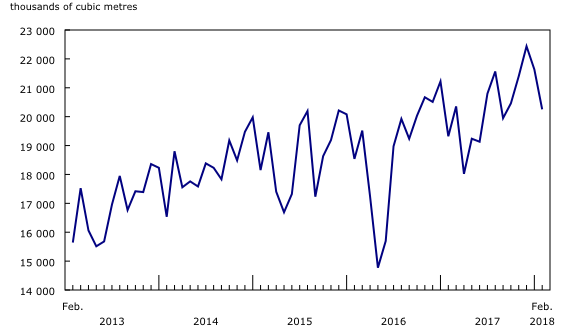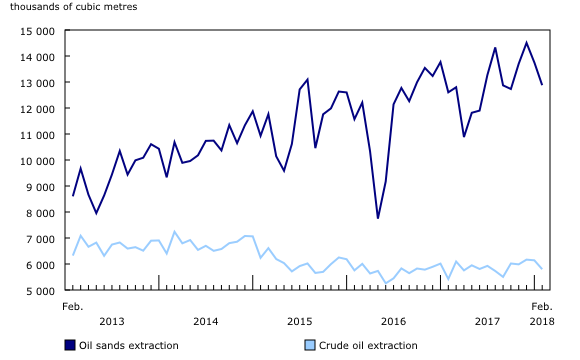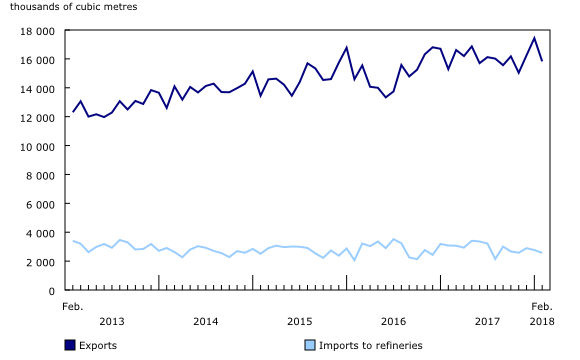Crude oil and natural gas: Supply and disposition, February 2018
Archived Content
Information identified as archived is provided for reference, research or recordkeeping purposes. It is not subject to the Government of Canada Web Standards and has not been altered or updated since it was archived. Please "contact us" to request a format other than those available.
Released: 2018-05-09
Canada produced 20.3 million cubic metres (127.4 million barrels) of crude oil and equivalent products in February, up 4.8% compared with the same month in 2017.
Crude oil production
In February, increases of light and medium crude oil (+12.1%), non-upgraded crude bitumen (+5.2%) and equivalent products (+21.6%) contributed to the overall rise in total production. Meanwhile, routine maintenance and turnaround from January's temporary outage at an Alberta facility was an ongoing factor in lower synthetic output (-2.3%).
The increase of non-upgraded crude bitumen in February was driven primarily by higher in-situ production (+3.2% to 7.2 million cubic metres). Over the same period, mined production edged up 0.2% to 6.4 million cubic metres, while crude bitumen sent for further processing declined 2.6% to 5.7 million cubic metres.
Crude oil extraction and oil sands extraction
In February, crude oil production (excluding equivalent products) totalled 18.7 million cubic metres, up 3.6% from the same month a year earlier. Oil sands extraction (formerly non-conventional oil extraction), which consists of non-upgraded crude bitumen and synthetic crude oil, increased 2.2% from the previous year to reach 12.9 million cubic metres. Oil extraction (formerly conventional oil extraction) of light, medium and heavy crude oils increased 7.0% to 5.8 million cubic metres.
Provincial production
Alberta produced 16.3 million cubic metres of crude oil and equivalent products in February, up 4.6% from the same month a year earlier. Alberta (80.7%), Saskatchewan (10.9%) and Newfoundland and Labrador (5.9%) comprised the majority of Canadian production of crude oil and equivalent products.
Refinery use of crude oil
Input of crude oil to Canadian refineries totalled 7.8 million cubic metres in February, up 3.5% from the same month a year earlier. Light, medium and heavy crude oils accounted for 65.8% of the total, while crude from oil sands represented the remaining 34.2%. Light and medium crude (4.0 million cubic metres) and synthetic crude (2.2 million cubic metres) continued to be the main types of oil used by Canadian refineries.
Exports and imports
Exports of crude oil and equivalent products were up 3.5% to 15.8 million cubic metres in February. The vast majority of exports (86.6%) were transported via pipelines to the United States, while exports by other means (including rail, truck, and marine) to the United States accounted for 10.0%. The remaining 3.4% of exports went to countries other than the United States.
Imports to refineries, which tend to be volatile, were down 16.6% to 2.6 million cubic metres.
Closing inventories
Closing inventories of crude oil and equivalent products were down 5.8% from the same month a year earlier to 18.6 million cubic metres in February. The total was comprised of transporters (-5.5% to 12.1 million cubic metres), refineries (-7.4% to 3.9 million cubic metres), and fields and plants (-4.6% to 2.6 million cubic metres).
Natural gas production
Marketable natural gas production in Canada totalled 13.5 billion cubic metres in February, up 8.0% from the same month a year earlier. Production of natural gas was concentrated in Alberta (68.9%) and British Columbia (29.1%).
Additional information on natural gas is available in "Natural gas transmission, storage and distribution," published in The Daily on April 18, 2018.
Note to readers
As of the January 2018 reference month, in accordance to the 2017 NAICS update (2017 NAICS), Conventional crude oil will be referred to as oil extraction, while non-conventional crude oil will be referred to as oil sands extraction.
Data on crude oil and equivalent products, previously found in CANSIM table 126-0001, are now published in CANSIM table 126-0003. While CANSIM table 126-0001 will remain available for reference, users should exercise caution when comparing data with those of the new CANSIM table.
Information on the disposition of crude oil and equivalent products to refineries by province and on exports to the United States by district were discontinued. New data on imports, exports, input to Canadian refineries and inventories were added to CANSIM table 126-0003.
Data from January 2017 to January 2018 have been revised.
Crude oil and equivalent products include heavy, light and medium crude oil, synthetic crude oil, crude bitumen, condensate, and pentanes plus.
Export data are a combination of National Energy Board data and survey respondents' data.
Import data include imports of crude oil by refineries and by others.
Total marketable gas includes receipts from fields, gas gathering systems and/or gas plants.
The crude oil and natural gas supply and disposition program uses respondent data as well as administrative data provided by federal, provincial and territorial authorities with regulatory responsibilities within their respective jurisdictions.
Contact information
For more information, or to enquire about the concepts, methods or data quality of this release, contact us (toll-free 1-800-263-1136; 514-283-8300; STATCAN.infostats-infostats.STATCAN@canada.ca) or Media Relations (613-951-4636; STATCAN.mediahotline-ligneinfomedias.STATCAN@canada.ca).
- Date modified:





